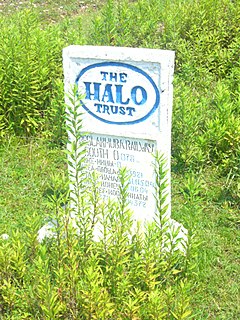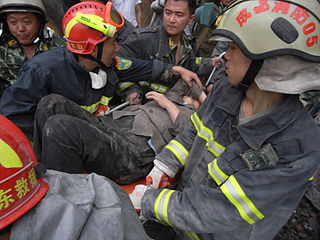The relief organisation "Medico International", which is one of participant to the International Campaign to Ban Landmines together with concept artist Peter Zizka collaborated under the motto of The Virtual Minefield in order to draw attention to the threat of land mines and unexploded ordnance in many of the world's countries.

The International Campaign to Ban Landmines (ICBL) is a coalition of non-governmental organizations whose stated objective is a world free of anti-personnel mines and cluster munitions, where mine and cluster munitions survivors see their rights respected and can lead fulfilling lives.

Peter Zizka is a German designer and conceptual artist.

A land mine is an explosive device concealed under or on the ground and designed to destroy or disable enemy targets, ranging from combatants to vehicles and tanks, as they pass over or near it. Such a device is typically detonated automatically by way of pressure when a target steps on it or drives over it, although other detonation mechanisms are also sometimes used. A land mine may cause damage by direct blast effect, by fragments that are thrown by the blast, or by both.
For this purpose, Peter Zizka created a floor-based art installation called “The Virtual Minefield” which photographically shows precise images of land mines. Those walking over it experience the bizarre beauty inherent in the pattern of varied shapes and materials. The terrible item is not immediately apparent. Within the scope of the art and charity event “600 x Bewegung schaffen – Räumt die Mine” (“600 x creating movement – clear the mines”) to raise money for the land mine victim fund of Medico International, it was possible to acquire 80 × 80 cm segments of the installation. Receipts were issued for the donations and at the end of the event the 600 limited art segments were distributed. Proceeds went and still go towards financing the extensive work of clearing minefields, psychological and physical rehabilitation measures for land mine victims and education programmes for the public with regard to the risks of land mines in Medico's project regions in Angola, Afghanistan, Cambodia and El Salvador.
Psychiatric rehabilitation, also known as psychsocial rehabilitation, and sometimes simplified to psych rehab by providers, is the process of restoration of community functioning and well-being of an individual diagnosed in mental health or mental or emotional disorder and who may be considered to have a psychiatric disability.

Physical therapy (PT), also known as physiotherapy, by using mechanical force and movements, manual therapy, exercise therapy, and electrotherapy, remediates impairments and promotes mobility and function. Physical therapy is used to improve a patient's quality of life through examination, diagnosis, prognosis, physical intervention, and patient education. It is performed by physical therapists.

Angola, officially the Republic of Angola, is a west-coast country of south-central Africa. It is the seventh-largest country in Africa, bordered by Namibia to the south, the Democratic Republic of the Congo to the north, Zambia to the east, and the Atlantic Ocean to the west. Angola has an exclave province, the province of Cabinda that borders the Republic of the Congo and the Democratic Republic of the Congo. The capital and largest city of Angola is Luanda.
It was possible to acquire segments via a campaign page. The Virtual Minefield is displayed as a pattern of many small squares. Similar to a game of Memory, the cleared fields are turned over and the donor is able to check which land mine-victim-program will receive the donation. After the cross-Europe exhibition tour he will receive the segment he chose on the website.
The Virtual Minefield received the Gold Award from the jury of ADC Deutschland and ADC Europe.

Installation art is an artistic genre of three-dimensional works that often are site-specific and designed to transform the perception of a space. Generally, the term is applied to interior spaces, whereas exterior interventions are often called public art, land art or intervention art; however, the boundaries between these terms overlap.

The HALO Trust is a non-political and non-religious registered British charity and American non-profit organization which removes debris left behind by war, in particular land mines. With about 6,000 deminers worldwide, HALO's largest operation is in Afghanistan, where the organization operates as an implementing partner of the Mine Action Programme for Afghanistan (MAPA).

The Queens Museum, formerly the Queens Museum of Art, is an art museum and educational center located in Flushing Meadows–Corona Park in the borough of Queens in New York City, United States. The museum was founded in 1972, and has among its permanent exhibitions, the Panorama of the City of New York, a room-sized scale model of the five boroughs originally built for the 1964 New York World's Fair, and repeatedly updated since then. It also has a large archive of artifacts from both World's Fairs, a selection of which is on display.

Demining or mine clearance is the process of removing land mines from an area. In military operations, the object is to rapidly clear a path through a minefield, and this is often done with devices such as mine plows and blast waves. By contrast, the goal of humanitarian demining is to remove all of the landmines to a given depth and make the land safe for human use. Specially trained dogs are also used to narrow down the search and verify that an area is cleared. Mechanical devices such as flails and excavators are sometimes used to clear mines.

A mine flail is a vehicle-mounted device that makes a safe path through a mine-field by deliberately detonating land mines in front of the vehicle that carries it. They were first used by the British during World War II.

Urban Search and Rescue involves the location, extrication, and initial medical stabilization of victims trapped in structural collapse due to natural disasters, mines and collapsed trenches.

Minefields in Croatia cover 351.00 square kilometres of territory. As of 2019, the minefields are located in 54 cities and municipalities within 8 counties. These areas are thought to contain approximately 31,000 land mines, in addition to unexploded ordnance left over from the Croatian War of Independence. Land mines were used extensively during the war by all sides in the conflict; about 1.5 million were deployed. They were intended to strengthen defensive positions lacking sufficient weapons or manpower, but played a limited role in the fighting.
Mine action is a combination of humanitarian aid and development studies that aim to reduce the social, economic and environmental impact of landmines and the explosive remnants of war (ERW).

No More Landmines was a United Kingdom-based humanitarian landmine relief charity. The charity focused on landmine and unexploded ordnance removal, mine risk education programmes, and rehabilitation of survivors of landmine injuries. No More Landmines was established in May 2005 as the UK administrator of the United Nations Association Adopt-A-Minefield campaign, which has cleared over 21 million square metres of affected land since 1999. The charity closed in 2015, according to the Charities Commission.

The United Nations Mine Action Service (UNMAS) is a service located within the United Nations Department of Peacekeeping Operations that specializes in coordinating and implementing activities to limit the threat posed by mines, explosive remnants of war and improvised explosive devices.

Franklin Furnace Archive, Inc. is an arts organization based in Fort Greene, Brooklyn, New York that serves to preserve and encourage the production of avant-garde art, particularly forms such as performance art that are under-represented by arts institutions due to their ephemeral nature or politically unpopular content.

An exhibition, in the most general sense, is an organised presentation and display of a selection of items. In practice, exhibitions usually occur within a cultural or educational setting such as a museum, art gallery, park, library, exhibition hall, or World's fairs. Exhibitions can include many things such as art in both major museums and smaller galleries, interpretive exhibitions, natural history museums and history museums, and also varieties such as more commercially focused exhibitions and trade fairs.

Mounir Fatmi is a Moroccan artist who lives and works in Paris. He studied at the Rijksakademie in Amsterdam. His multimedia practice encompasses video, installation, drawing, painting and sculpture. He works on obsolete materials and their uncertain futures, he criticizes the illusory mechanisms that bind humanity to technology, ideologies and their influences in a society in crisis.
In 2006, he won the Uriöt prize, Amsterdam, the grand prize of the Dakar Biennial and the Cairo Biennial Award in 2010.
Piero Gilardi is a visual artist. Born in Italy from a Swiss family, he studied at the Liceo Artistico in Turin. In an interview with LeGrace G. Benson, Gilardi stated that his personal encounter with artist Michelangelo Pistoletto and others helped him in the development of his own artwork. While trying to comprehend the cybernetic idea of feedback and the scientific rational behind man's mental synthesis, his perspective on reality changed; he then focused on the fluxus and relationship of things around him.

The Boise Art Museum (BAM) is located at 670 Julia Davis Drive in Boise, Idaho, and is part of a series of public museums and cultural attractions in Julia Davis Park. It is the permanent home of a growing collection of contemporary realism, modern and contemporary ceramics, as well as the largest public collection of works by acclaimed Idaho outsider artist and bookmaker James Charles Castle. The museum also features major traveling exhibitions and installations throughout the year.
The Mine Kafon Drone is a drone for demining, led by Afghanistan-born Massoud Hassani. The drone is designed to map an area for land mines, detect the mines, and then detonating them remotely. It has been field-tested with the Dutch Ministry of Defence. The use of a drone is safer and less expensive than typical methods for mine removal, which endanger trained mine disposal experts and dogs. The Mine Kafon Foundation, established by Hassani in 2013, is based in Eindhoven, Netherlands.
Rita Rohlfing is a German painter, photographer and installation artist.

















